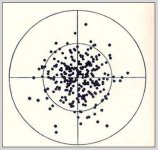One has to remember statistics of the sort we are using here are meant to estimate how identical rounds will behave in the future. You want to know something about group size because you want to know how reliably you can hit a certain size of target in the future with that same load. They don't lie. Lying with them is done on purpose by people cherry-picking from among statistics to cite one that, in isolation, appears to confirm a bias they want to claim support for. Misunderstanding significance is a way people can fool themselves about what statistics mean, and in shooting it is usually this latter situation that arises.
TL,
I think a group's radial SD is a Rayleigh distribution. We should check with member Statshooter, who teaches this stuff for a living. You can also look at a group as a bivariate Gaussian distribution, with one distribution on each of two perpendicular axes, assuming you want to keep negative numbers intact to indicate left or right or up or down relative to the mean.
Statshooter always uses 30 round samples and has a good rationale for using this number. I was editing it at one point to put into a sticky. I'm way behind and should finish that and put it up.
If you have an infinitely large sample with either distribution, the median absolute distance from the mean (the distance that contains half the population) is at 0.674 standard deviations, so the 7.5" radius shown by Mehavey for M2 should be at 6.74" by my figuring, but they are in the ballpark and you don't expect to resolve all those decimal places without firing closer to a 1000 round sample. In any event, the mean radius has a constant relationship to the SD in an infinitely large sample, so either is a valid basis for comparing groups.

